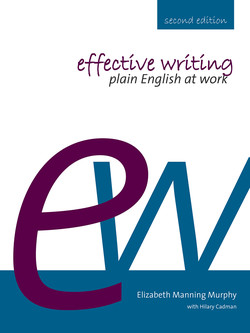Читать книгу Effective Writing - Elizabeth Manning Murphy - Страница 15
На сайте Литреса книга снята с продажи.
1.9 Correct writing
ОглавлениеPrimarily, effective writing is correct writing. How do we know whether our writing is correct? We know when we have followed the conventions for correct writing in the standard form of English. I like to think of writing effectively as following a set of ‘conventions’ – that is, what is currently considered acceptable grammar. The word ‘rule’ is, to me, very strict. Nowadays, as we’ll discover, it is sometimes acceptable to bend or break some of the old rules.
It is difficult to talk about what is or is not correct if we do not know the terms that are used to describe the many areas of writing. You probably learnt some of these terms at school – do noun, verb, phrase, clause, active or passive ring any bells with you? Whether you left school last year or a long time ago, you may have forgotten these terms, so Part A of the book is designed to remind you.
Some participants in courses ask: Why do I have to know these terms? Can’t I just learn to write?
If you learn to be a doctor or a lawyer, a plumber or a salesperson, you learn the terms and formulas that everyone in that profession or trade uses. You have chosen to learn to develop your writing skills, so you need to understand the language of writing, and some of the terms that are used in the writing business.
Writing consists of strings of words, broken up by punctuation marks, and arranged in chunks of several lines each. If you don’t conform to a writing pattern that your readers will understand, you cause confusion. This confusion may take the form of hesitation, a need to re-read a passage, or doubt about the meaning of a group of words. When you write in a confused style, your readers have to ask for clarification; or supervisors tell you to write it again because it ‘doesn’t make sense’.
How do you know what to correct if you are told that your writing ‘doesn’t make sense’? If you are a supervisor, how do you explain to the writer exactly what is causing the confusion in the document? The only way is to use the terminology of grammar or of style. You can then be precise. If it’s a grammar problem, for instance, you can say: ‘This sentence is confused because the verb doesn’t agree with the subject’ or ‘It would flow better if we used commas between the clauses instead of all these conjunctions’. It is worth taking the time to learn the terms because then you will understand why a sentence doesn’t make sense – rather than just relying on instinct or on the feeling that it sounds wrong. If you understand why a sentence doesn’t make sense, you’ll be able to explain it to others.
The early chapters in this book are about essential grammar. There are not many terms to understand, and you should not memorise mere definitions. It is more important to get a feel for how nouns differ from verbs, when to use adverbs and when to use adjectives, which punctuation marks to use where, and so on. If you can do this, you will be on the way to understanding the difference between good and bad writing. That understanding will certainly help you to write better, and help you to help others to write better.
A quick skim of Part A – The basics may be all you need to bring the terms and the functions of the various parts of the sentence to mind. Or you may wish to work right through, completing all the activities along the way. If you make a lot of mistakes in an activity, you may need to revise the whole section – talk to your instructor or consult a full grammar text. It is not a good idea to skip over something you haven’t fully understood. When you have completed the section, you should be more confident that your writing will be grammatically acceptable.
Theory is kept to a minimum – indeed, there is only as much of it as is necessary to remind you of the terms and the way words work in the most straightforward of sentences.
Chapter 2 is a grammar assessment for you to try. It will show where some of the gaps are in your understanding of the basics. After this activity, we will look at the smallest units of writing: words – how to spell them and how they function in sentences.
